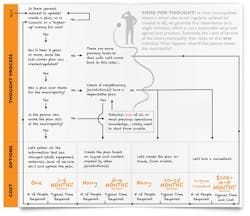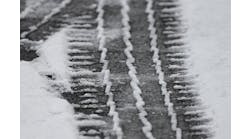“Why does this need to be so complicated and time-consuming?”
“Are we missing anything?”
“There has to be a better way!”
Those were some of the questions and remarks that both of us used to ask ourselves whenever the time came to sit down and write the snow plan for our municipalities, an all-encompassing document that should ideally have all the details of how a municipality is to plan for and execute its snow operations for the coming winter season.
As members of public works, albeit from two different countries (U.S. and Canada), we both understood the value of developing proper snow plans for the winter seasons, but the sheer complexity and logistics that went with writing one were always a big turnoff. And we certainly were not the only ones. The number of municipalities in North America that do not maintain a formal, annual snow plan is much larger than what it should be—mostly due to lack of time, resources and expertise in crafting legal documents. Thankfully, we stumbled upon a solution that alleviated our respective snow plan crisis. It is called the Winter Web App (www.OGRAapps.com).
Fast forward to today, and, after making use of the app, our jurisdictions (city of Fargo in North Dakota and county of Middlesex in Ontario) have comprehensive snow plans that are actionable, and which practically wrote themselves. For the future winter seasons, we will literally only have to click a single button to generate subsequent plans. In terms of time-dollar savings, our experience can serve as a successful case study other struggling departments of transportation and public works would do well to follow.
Figure 1. An example of what it takes for municipalities to make a winter maintenance plan.
Life before the app
The typical process of creating a municipal snow plan that covers the entire set of winter operations (including staff, equipment, material, level-of-service policies and so forth) can be quite intimidating. Figure 1 gives a glimpse into the thought processes, options and costs in terms of time and money that municipalities go through when faced with having to create a snow plan. Given the efforts required by each of the municipalities in creating their snow plans, is it then really a surprise that many municipalities, notably those struggling financially, are usually left with no choice but to operate without an official, up-to-date snow plan?
In our municipal world experience, we’ve come to generally associate the word “software” with “difficult to use” and “over promised and under delivered.” We are not against technology, but a set of bad experiences in dealing with software in the past did make us cringe a bit every time we heard the term “new software.” It was these old software wounds from the past that initially kept us away from jumping hands-and-feet into the winter app world. After all, this new service was promising something no one had attempted before: “Just answer straightforward questions, and the Winter Web App will generate the comprehensive, fully customized snow plan for you.” What’s more, app developers were projecting that most user municipalities would be able to generate their plans “within a week.” Frankly, it sounded too good to be true. That is, until we started using it ourselves.
Modules of access for plan building.
Content is king
There are many professional-grade software titles available in the market today that look like they were intentionally made to be “user-hostile” instead of “user-friendly.” Then there are software titles that are gorgeous to look at, but the developers completely missed the ball on the solution they were supposed to provide. From the signup process to answering the winter operations questions to creating our plow routes, and all the way up to downloading and printing of the PDF of our 100-plus-page snow plan (with colorful maps included), we found the Winter Web App to be very simple to use. Despite tackling a very complex task of making a professional snow plan, the software never became overwhelming to deal with.
Having a user-friendly software is great, but what benefit would there be if the software didn’t solve the problem it was created to address? That was certainly not the issue in this case. After we answered a series of winter maintenance-related questions, the system generated a document that covered many of the topics crucial to a comprehensive plan, including:
- Winter preparations;
- Level of service;
- Winter patrolling;
- Staffing and hours of service;
- Winter materials used;
- Application rates;
- Winter maintenance equipment;
- Works yard details;
- Plow routes;
- Sidewalk clearing routes;
- Snow removal and disposal;
- Salt vulnerable areas;
- Communication and protocols;
- Jurisdiction boundary responsibilities;
- Operating instructions;
- Health and safety; and
- Plan improvements.
The content template for the app was generated through extensive consultations with public works directors from both the U.S. and Canada, all of whom have extensive experience in planning and operations for their respective jurisdictions. By doing so, the team essentially gathered various flavors of winter maintenance plans from the two countries, unified them together and developed a template that covers nearly all types of winter-related planning and operations, in one place.
The final document readied as a PDF.
Let there be route maps
One of the most useful features of the app is the plow route mapping. The mapping component is extremely simple to use, following through with the overall user-friendly nature of the software. We simply had to click along the plow route to designate and build it into the plan. The system is smart enough to recognize the roadway underneath and therefore the routes are drawn automatically, closely following even the toughest road curves. This resulted in professional-looking route maps that are automatically inserted into the final PDF file.
This feature has allowed us to take full control of our maps, as there is no longer a need for us to keep going back-and-forth with our local GIS department every time we want to make a change to our routes. The time-dollar savings here is significant. Furthermore, the app also allows for creating maps of local jurisdictional boundaries, patrol routes and salt-vulnerable areas. It even goes so far as to allow for the plotting of sidewalk maintenance routes separate and distinctly from roads.
The app process streamlines an otherwise costly and time-consuming process.
Time is money
As mentioned earlier, one of the big reasons why many municipalities shy away from creating annual winter maintenance plans is because of the time required for the activity. Per Figure 1, it can take a municipality months or even years to come up with a good plan. So, it is usually not until someone “from the top” (or worse, someone from the legal department) comes asking for the plan that all the wheels go in motion. It is then usually a rush to find the closest municipality that already has a plan in place, and effectively “borrowing” the content. Even when working from someone else’s plan, it is still a time-consuming process and in the end the content is generally only as good as the plan it was borrowed from.
With the app, however, the process of creating the plan is streamlined compared to the manual process, which saves tremendous amounts of time for the municipality. In our experience, if one were to calculate the exact hours spent answering the app questions, the entire effort took less than a week’s worth of work. What’s more, all this was done with our own staff, eliminating the need for (and associated cost of) an outside consultant. Once all the questions have been answered for the current season, all the feedback is passed onto the following season(s) with a single click of the FINALIZE button.
With that single click, the system carries out two important tasks:
1) All current season’s feedback is seamlessly transferred to the following season; and
2) The current season’s PDF is locked and saved under the PREVIOUS WINTER DOCUMENTS section.
What this means is that creating your subsequent plan is only a matter of updating the information that may change from one winter season to the next, e.g., new staff; change in equipment; new or updated yard facilities; amendments to plow routes; or revision of level-of-service policies.
All this translates into a fraction of municipal time and resource requirement when compared to the usual/manual way of creating winter maintenance plans. In our collective experience, a municipality can easily save months of work through this service.
As part of the app subscription, we also received the Events Tracker Add-On, which allows us to keep very detailed information on winter storm events we have dealt with. This is a service that can help municipalities replace their paper-based tracking with a standardized, online tracking.
The Events Tracker Add-On allows us to capture the following details about every storm:
- Start/end dates and times;
- Start/end of actual winter operation;
- List of staff and equipment involved;
- List and amount of material used;
- Daily snow accumulation; and
- General comment entries.
Additionally, the tracker comes with a chart view that graphically shows all storm events, giving a visual understanding on how the operations and storms interacted with one another. The chart also plots snow accumulations in comparison to the worst/highest accumulation ever recorded by the user municipality.
A route map designed for a specific neighborhood.
Final thoughts
In today’s world, municipalities across North America are constantly having to do more with less. Lack of funds, resources and time are persistent constraints unlikely to go away in the foreseeable future. If anything, the pressure is only going to increase. Given that the odds are clearly not in our favor, it is refreshing to see that the industry is stepping up in understanding the critical areas where we need support, and providing affordable solutions that are designed to work within our constraints.
The Winter Web App has helped Middlesex by allowing us to minimize staff time and reduce our costs with preparing and maintaining our winter maintenance plan, and greatly improving our ability to defend our municipality against winter-related road incident claims. And from the city of Fargo perspective, it is a user-friendly program that allows our winter maintenance plan to be a living document that can be effortlessly updated at any time without having to recreate the wheel.
In just three years since launch, the app has gained the support of more than 200 municipalities across North America. It is certainly a service that has won itself its rightful place in both of our winter maintenance planning and operations toolboxes.
This map shows how an individual route can be adjusted or modified.


